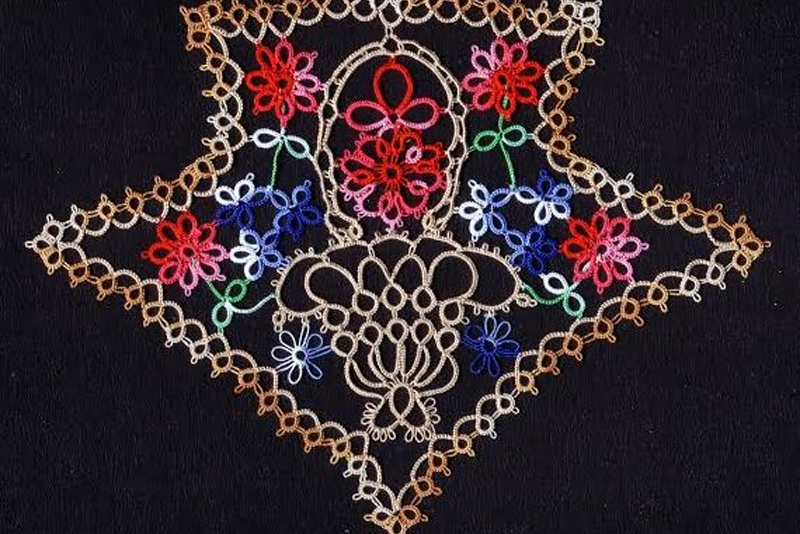tatting Newsletter

April 3 2012 Tatting Newsletter
Tatting, of all the types of laces, may be the oldest. Although the origins of tatting are shrouded in the mists of history, the basic double stitch, a.k.a. larks’ head knot, is the same stitch that has been used on the nets of fishermen for centuries. Unlike knitting and crochet, tatting is a form of lace that does not unravel. Tatting is both delicate in look and sturdy in construction. It often survives longer than the cloth which it embellishes.
Online we can find many sources which give the history or origins of tatting. Many contain good information; some perpetuated "myths" and others are just "misinformed." We will never know for certain but it is good to review what we do know.
http://en.wikipedia.org/wiki/Tatting
http://www.georgiaseitz.com/books/cw/cwtat.html
http://abctattingpatterns.com/history/
http://www.tribbler.com/tatman/ (click misc, then click origins of tatting)
http://www.ringoftatters.org.uk/whatis/whatis.html
http://www.ringoftatters.org.uk/heritage/tatting19/tatting19.html
http://www.ringoftatters.org.uk/heritage/tatting20/tatting20.html
http://www.victoriana.com/Embroidery/tatting.htm
http://www.ilchiacchierino.com/CenniE.htm
Now, I do believe that tatting goes back to pre-history, but 30,000 years old seems a bit exaggerated to me. But, read this vintage article for yourself.
"300 Centuries of Ogle County Life Shown by Relics"
Did the Ladies of 30,000 Years Ago Do Tatting?
Republic Staff Correspondent Asks.
Polo, IL April 12, 1920, The Republic.
"Did the Ogle country ladies of 30,000 years ago do tatting?
Did the stone age children of Polo play with flint and granite birds or was some bird accepted by the "oldest inhabitants" as a god?
These and many other questions flashed through the Republic corespondent's mind as he looked over the marvelous collection of relics left by the Indian and their predecessors, which is in the possession of M. E. Schryver, Polo insurance man.
Although he would not admit it, Mr. Schryver is a scientist and he assured us that 30,000 years is a conservative estimate of the age of many of his relics. Europe and Asia delight in chaffing America for its youth and conspicuous new-ness, and though we may reply that progress and modern inventions are more to be desired than antiquity, the back ground of our minds holds a desire for some ancient soil wherein America may strike her roots and feel that she, too, has at least a respectable antiquity.
It is with an interest in which triumph plays a large part, therefore, that we learn of life that existed in northern Illinois 30,000 years ago! In the misty, pre-historic days before the glacier when American aborigines - ancestors of the Indian - roamed the prairies and riverbanks of Ogle county, they lived a life that was picturesque and interesting, and left their implements of warfare and commerce, so that we can learn today in some measure what kind of men they were.
7,000 Pieces in Collection
7,000 pieces are contained in Mr. Schryver's collection, of which 5,000 are arrowheads. So many arrowheads - and yet every one different! There are some tiny specimens no larger that one's finger nail, perhaps the property of some dainty aborigine lady or the warlike plaything of her child. There are huge ones, almost as large as a hand. Some are broad; some are long and slender some are of hard, forbidding flint, others of glistening agate and bright colored stones of various kinds.
Ancient "Tatting Shuttles"
Celts, and hide-scrapers, spearheads, and knife-blades of hardest stone are there, bearing eloquent testimony of America's stone age. Some of the relics, however, remain a puzzle for scientists. Mr. Schryver has several specimens of the rare "bird stones" whose use may never be known, queer objects made in the form of a bird, but seemingly without practical application. Then there are the "banner stones," pieces of a peculiar kind of banded flint with alternate gray and black stripes and shaped much like a modern tatting shuttle. All are perfectly rounded off and were evidently designed for some delicate use, which naturally led to our speculation - "did the ladies of 30,000 years ago do tatting?"
Articles of industry and commerce give an idea of ancient life in Ogle county. Huge stone mauls, pestles and pottery, pipes, spades, and hoes show that agriculture - the leading industry of this region - has flourished on this same soil for centuries, accompanied by the kindred arts, milling and cooking..."
Ed's note: American Indians of the Plains did indeed learn tatting as well as other laces from missionaries of the 19th and 20th century. But at 30,000 years ago no cotton nor flax was in cultivation to produce thread for lacemaking on any kind. Geez...
Here's the latest article from the Tatting site at BellaOnline.com.
Building Good Tension Ring by Ring
Building good tension with one shuttle work, rings only; small projects to practice.
http://www.bellaonline.com/articles/art25821.asp
Please visit tatting.bellaonline.com for even more great content about Tatting.
To participate in free, fun online discussions, this site has a community forum all about Tatting located here -
http://forums.bellaonline.com/ubbthreads.php?ubb=postlist&Board=39
I hope to hear from you sometime soon, either in the forum or in response to this email message. I thrive on your feedback!
Have fun passing this message along to family and friends, because we all love free knowledge!
Georgia Seitz, Tatting Editor
http://tatting.bellaonline.com
One of hundreds of sites at BellaOnline.com
Unsubscribe from the Tatting Newsletter
Online Newsletter Archive for Tatting Site
Master List of BellaOnline Newsletters
Editor's Picks Articles
Top Ten Articles
Previous Features
Site Map






